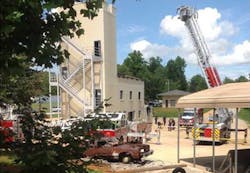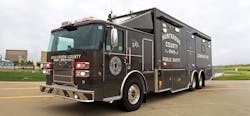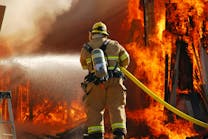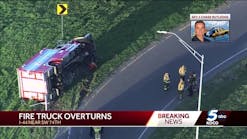We all know there are inherent dangers and risks with firefighting. We also know mechanical things break down. So, there shouldn’t be any surprise when equipment and apparatus used for firefighting fail and people, unfortunately, get hurt.
That’s never a good thing and we should always try to avoid breakdowns and injuries. And, sometimes, people need to be held accountable for the failures. At the very least, there needs to be review to reduce the chances of whatever happened from happening again.
There seems to be a greater than normal number of incidents of mechanical failures and product recalls in the fire service than usual – at least making news that is. It’s not unprecedented, but it seems like good time to step back and take a broader view.
For as long as there have been machines and equipment helping firefighters do their jobs, there have been failures of equipment and apparatus. And I can assure you, there will be long after we all retire from the fire service.
From cables on aerials snapping to wheels falling off apparatus, to PPE being recalled because of seam failures, recalls and safety bulletins abound.
According to the federal National Highway Traffic Safety Administration, there were 632 vehicle recalls issued by manufacturers, involving 21,963,918 vehicles reported in 2013. Keep in mind, that includes everything from Toyota's to trailers and everything in between.
However, a few dozen of those recalls from several fire apparatus manufacturers affected close to 12,000 rigs. From those numbers, it’s hard to ignore the fact that recalls and mechanical defects from the manufactures are parts of life.
While it’s more difficult to document issues with rescue tools, PPE, power and hand tools, and myriad of other equipment used in the fire service, it’s fair to say there are countless recalls in those vocations each year as well affecting the stuff we use every day. As long as they are acknowledged, and rectified, life goes on.
In my present position with Firehouse and in my previous employment with a magazine dedicated to fire apparatus and equipment, I’ve personally traveled to virtually every major apparatus manufacturer’s plant in the United States as well as many tool and component builders and PPE manufacturers. I’ve met with owners and presidents of the companies and I can assure that not one of them would ever intentionally send out a defective piece of equipment or truck. Many of them have their names on the equipment and have three and four generations of their family working for the company.
It makes no sense that those business owners would jeopardize their very livelihoods, or the family name and legacy. Even the big publicly held companies wouldn’t intentionally send out shoddy products – it wouldn’t be good for the investors.
And, on top of all that, many of the people I’ve met who invent, make and distribute fire equipment are, or have been, firefighters themselves. And, aren’t we the folks known for having each other’s backs?
And let’s not forget maintenance, and lack thereof, can be significant factors in mechanical failures. That’s a given.
Things happen and people do get hurt and even die, and there’s no denying that those events are truly tragedies. Investigations must be conducted to get to the bottom of what happened. And, in many cases, people need to be held accountable. At the very least to make sure the same mistakes and problems don’t injure or claim others in the future.
But the blame game can exact too much pain and suffering on people who have nothing to do with the failure. I am thinking about the Hall County, Ga., fire chief who was fired for reportedly not knowing, or revealing the history of a used aerial that sustained cable failure and injuring three firefighters. The word scapegoat comes to mind. I guess someone needed to be held accountable and, in this case, it was the fire chief.
When things do happen, how the manufacturer reacts is critically important. Those who immediately acknowledge the problem, tell their customers about it and then work quickly to rectify the problem are being responsible and accountable.
Companies that deny, deflect and obfuscate might have to be prodded with legal actions and threats, and that’s justified without question. We don’t want or need greedy, negligent companies in the fire service. Too much is at stake for those kind of businesses to pollute the profession.
We need to keep in mind, however, that those who make products and fire apparatus for us to do our jobs need some protection to innovate and manufacture tools that save lives.
There are risks in business, just as there are risks in firefighting. Business owners accept risks for the financial rewards and the altruistic ideals of saving the world. We need those innovative businesses to build our fire trucks, design our next SCBAs so we can do our jobs and help save the world. Our goals and risks are not that far apart.
Crippling personal injury lawsuits stifle innovation and can sometimes shutter good businesses producing good products. I am not saying we should ignore greed and willful negligence. As I said, we don’t want or need that kind of business in the fire service. Good companies, making good quality products in the name of trying to keep us safe should have a bit of leeway to do what they do.
There is already too little incentive to manufacturer equipment that allows people to go into burning buildings and work in environments that are immediately dangerous to life or health without some protection. Why would any sane business person try to make a fire suit that allows a human to go into a burning building and work. I can say they’re kindred spirits, competitive and risk takers as almost any firefighter.
While they don’t deserve a blank check to mess with the safety of our nation’s firefighters, they need some protection and support or they won’t be able to stay in business.
And then, we’ll have to go back to fighting fires with leather buckets. Of course even buckets aren’t without risk. The stitching could come out and someone could slip and fall on wet cobblestone.






